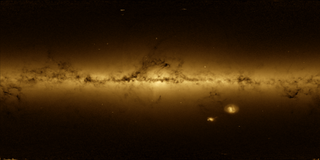See a Virtual Milky Way Map from Europe's Gaia Spacecraft

The European Gaia space observatory is hard at work mapping our Milky Way Galaxy in unprecedented detail. Case in point: this virtual Milky Way map unveiled by Gaia mission scientists at the European Space Agency.
ESA launched the Gaia spacecraft in 2013 to make the most precise 3D map of stars in the Milky Way, as well as a map of its neighbors' stars – the Large and Small Magellanic Clouds. Earlier this year, ESA scientists unveiled Gaia's first billion-star map of the Milky Way. On Thursday (Nov. 10), the space agency also released this new virtual map based on data from the spacecraft. [Gaia's Milky Way Mapping Mission in Pictures]
"These engineering data have been accumulated over 18 months and combined to create a 'map' of the observed star densities, from which a beautiful and ghostly virtual image of our magnificent Milky Way galaxy can be discerned, showing the attendant globular clusters and Magellanic clouds," ESA officials wrote in an image description. "Where there are more stars, as in the Galactic center, the map is brighter; where there are fewer, the map is darker. The map includes brightness data corresponding to several million stars," they wrote in the same description.
The $1 billion (740 million euros) Gaia spacecraft is designed to create a high-resolution map of 1 billion stars in the Milky Way over the course of a five-year mission. The spacecraft is making its observations from a gravitationally stable point, called the sun-Earth Lagrange Point 2, or L2, about 930,000 miles (1.5 million kilometers) from Earth.
You can find out more about the Gaia mission in our mission video here.
Email Tariq Malik at tmalik@space.com or follow him @tariqjmalik and Google+. Follow us @Spacedotcom, Facebook and Google+. Original article on Space.com.
Get the Space.com Newsletter
Breaking space news, the latest updates on rocket launches, skywatching events and more!
Join our Space Forums to keep talking space on the latest missions, night sky and more! And if you have a news tip, correction or comment, let us know at: community@space.com.

Tariq is the Editor-in-Chief of Space.com and joined the team in 2001, first as an intern and staff writer, and later as an editor. He covers human spaceflight, exploration and space science, as well as skywatching and entertainment. He became Space.com's Managing Editor in 2009 and Editor-in-Chief in 2019. Before joining Space.com, Tariq was a staff reporter for The Los Angeles Times covering education and city beats in La Habra, Fullerton and Huntington Beach. In October 2022, Tariq received the Harry Kolcum Award for excellence in space reporting from the National Space Club Florida Committee. He is also an Eagle Scout (yes, he has the Space Exploration merit badge) and went to Space Camp four times as a kid and a fifth time as an adult. He has journalism degrees from the University of Southern California and New York University. You can find Tariq at Space.com and as the co-host to the This Week In Space podcast with space historian Rod Pyle on the TWiT network. To see his latest project, you can follow Tariq on Twitter @tariqjmalik.
